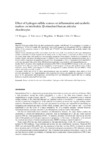Mostrar o rexistro simple do ítem
Effect of hydrogen sulfide sources on inflammation and catabolic markers on interleukin 1β-stimulated human articular chondrocytes
| dc.contributor.author | Burguera, Elena F. | |
| dc.contributor.author | Vela-Anero, Á. | |
| dc.contributor.author | Magalhaes, J. | |
| dc.contributor.author | Meijide-Faílde, Rosa | |
| dc.contributor.author | Blanco García, Francisco J | |
| dc.date.accessioned | 2015-06-10T11:59:49Z | |
| dc.date.available | 2015-06-10T11:59:49Z | |
| dc.date.issued | 2014-07 | |
| dc.identifier.citation | Burguera EF, Vela-Anero Á, Magalhaes J, Meijide-Failde R, Blanco FJ. Effect of hydrogen sulfide sources on inflammation and catabolic markers on interleukin 1β-stimulated human articular chondrocytes. Ostheoarthritis Cartilage. 2014;22:1026-1035. | es_ES |
| dc.identifier.uri | http://hdl.handle.net/2183/14657 | |
| dc.description.abstract | [Abstract] Objective. Hydrogen sulfide (H2S), the third gasotransmitter together with NO and CO, is emerging as a regulator of inflammation. To test if it might offer therapeutic value in the treatment of osteoarthritis (OA) we evaluated the effects of two exogenous sources of H2S, NaSH and GYY4137, on inflammation and catabolic markers that characterize OA. Method. Human chondrocytes (CHs) were isolated from OA tissue. Cells were stimulated with a pro-inflammatory cytokine (interleukin-1β, IL1β, 5 ng/ml) and the ability of the two H2S sources to ameliorate its effects on the cells was tested. Nitric oxide (NO) production was quantified through the Griess reaction. Protein levels of inducible NO synthase (NOS2) and matrix metalloproteinase 13 (MMP13) were visualized through immunocytochemistry (ICC). Relative mRNA expression was quantified with qRT-PCR. Prostaglandin-2 (PGE-2), interleukin 6 (IL6) and MMP13 levels were measured with specific EIAs. NFκB nuclear translocation was visualized with immunofluorescence. Results. Both H2S sources led to significant reductions in NO, PGE-2, IL6 and MMP13 released by the cells and at the protein level. This was achieved by downregulation of relevant genes involved in the synthesis routes of these molecules, namely NOS2, cyclooxigenase-2 (COX2), prostaglandin E synthase (PTGES), IL6 and MMP13. NFκB nuclear translocation was also reduced. Conclusion. NaSH and GYY4137 show anti-inflammatory and anti-catabolic properties when added to IL1β activated osteoarthritic CHs. Supplementation with exogenous H2S sources can regulate the expression of relevant genes in OA pathogenesis and progression, counteracting IL1β pro-inflammatory signals that lead to cartilage destruction in part by reducing NFκB activation. | es_ES |
| dc.description.sponsorship | This work was supported in part through funding from the Fondo Investigación Sanitaria, Madrid, Spain (CIBER-CB06/01/0040; PI12/00329; RETIC-RIER-RD12/0009/0018; and Proteo-Red/ISCIII); Ministerio Ciencia e Innovación PLE2009-0144, FEDER (European Community) and Xunta de Galicia: grant 10 PXIB 310153 PR and Red Gallega REDICENT. | es_ES |
| dc.description.sponsorship | Instituto de Salud Carlos III; CIBER-CB06/01/0040 | |
| dc.description.sponsorship | info:eu-repo/grantAgreement/MINECO/Acción Estratégica de Salud/PI12%2F00329/ES/PROYECTO PROTEOMA HUMANO ESPAÑOL: Aplicacion en Enfermedades Reumatologicas | |
| dc.description.sponsorship | Instituto de Salud Carlos III; RD12/0009/0018 | |
| dc.description.sponsorship | info:eu-repo/grantAgreement/MICINN/Programa Nacional de Internacionalización de la I+D/PLE2009-0144/ES/In situ Tissue Engineering using Stem Cells and Functional Biomaterials to Repair Articular Cartilage: An ''in Vivo Model" | |
| dc.language.iso | eng | es_ES |
| dc.publisher | Elsevier | es_ES |
| dc.relation.uri | http://dx.doi.org/10.1016/j.joca.2014.04.031 | es_ES |
| dc.rights | Creative Commons Attribution-NonCommercial-NoDerivs 4.0 International License (CC-BY-NC-ND 4.0) | |
| dc.rights.uri | http://creativecommons.org/licenses/by-nc-nd/4.0/ | |
| dc.subject | Human articular chondrocytes | es_ES |
| dc.subject | Osteoarthritis | es_ES |
| dc.subject | Hydrogen sulfide | es_ES |
| dc.subject | Inflammation | es_ES |
| dc.subject | Metalloproteinase | es_ES |
| dc.title | Effect of hydrogen sulfide sources on inflammation and catabolic markers on interleukin 1β-stimulated human articular chondrocytes | es_ES |
| dc.type | info:eu-repo/semantics/article | es_ES |
| dc.rights.access | info:eu-repo/semantics/openAccess | es_ES |
Ficheiros no ítem
Este ítem aparece na(s) seguinte(s) colección(s)
-
GI-TCMR - Artigos [130]
-
INIBIC-TCMR - Artigos [102]
-
INIBIC- REUMA - Artigos [184]






